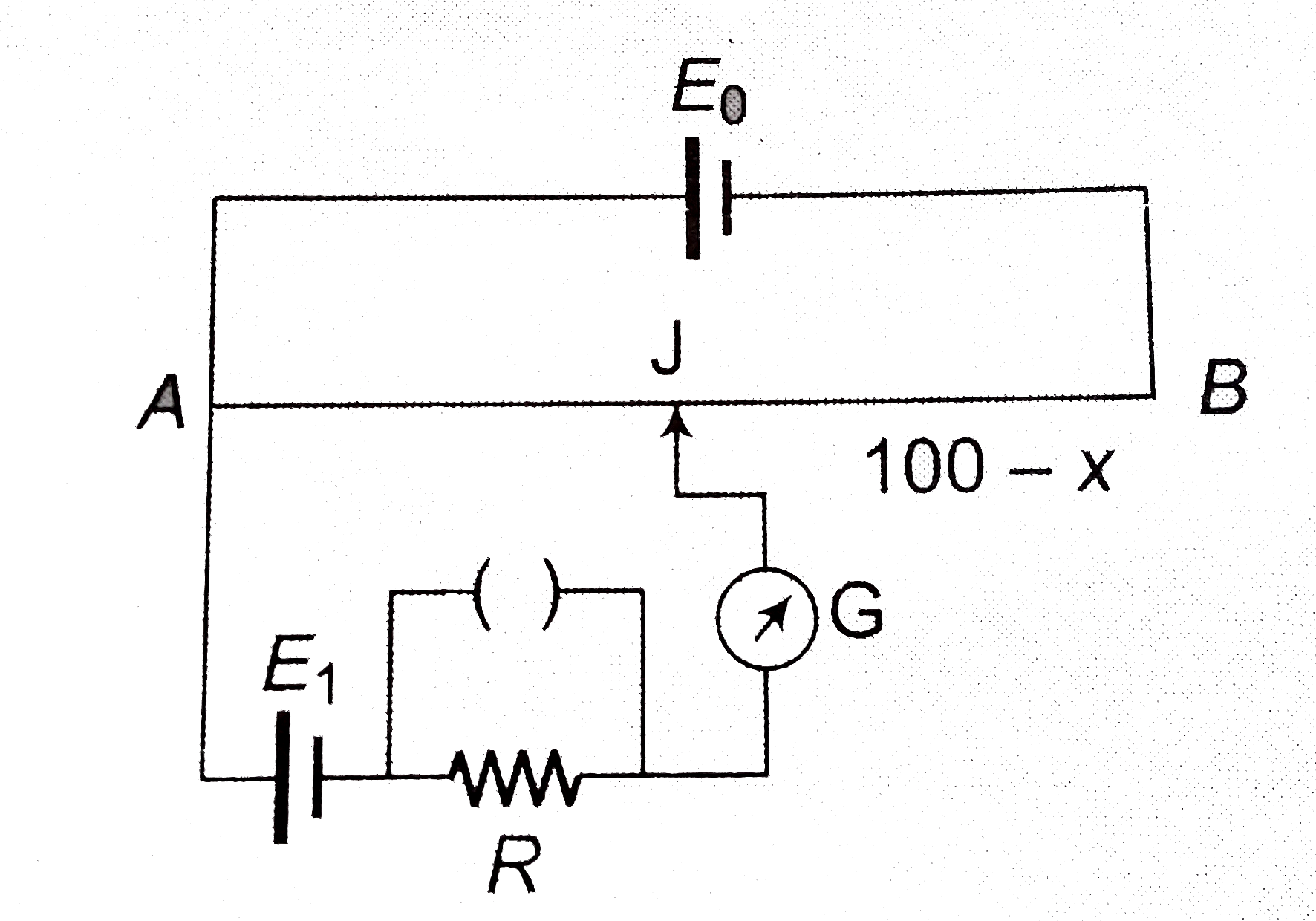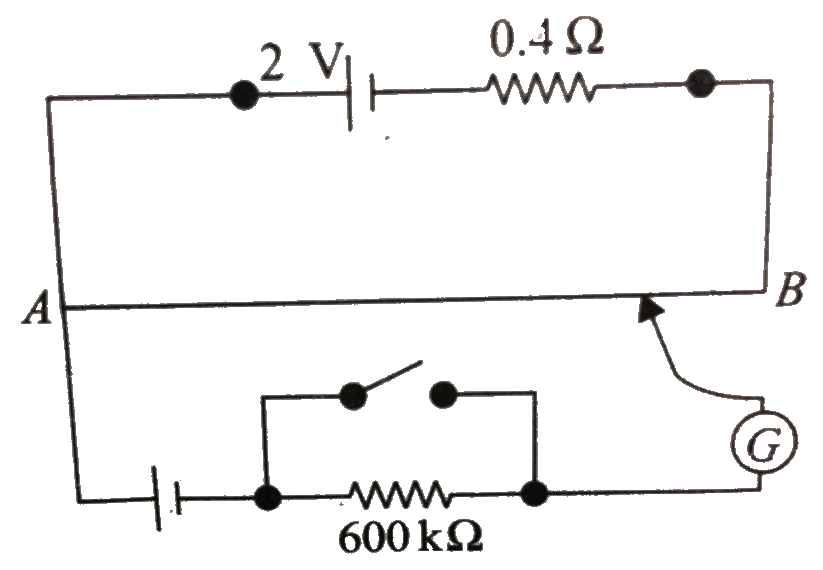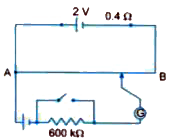
The figure shows a potentiometer using a cell of emf and internal resistance connected to a resistor wire . A standard cell of constant emf of gives a balance point a t length of the wire. A very high resistance is put in with the standard cell. This resistance is shorted by inserting switch when close to the balance point. The standard cell is then replaced by a cell of unknown emf and the null point turns out to be length of the wire.
(a) What is the value of ?
(b) What is the purpose of using the high resistance ?
( c) Is the null point affected by this high resistance ?
(d) Is the null point affected by the internal resistance of the cell ?
( e) Would this method work if
(i) the internal resistance of cell were higher than the resistance of wire and
(ii) the emf of cell were instead of ?
The correct Answer is:(a) 1.25 V,
(b) saving of glvanometer from damage and to prevant the cell discharging fast
( c) No, (d) Yes, ( e) No, (f) No
Step by step video, text & image solution for The figure shows a potentiometer using a cell E of emf 2.0 V and internal resistance 0.40 Omega connected to a resistor wire AB. A standard cell of constant emf of 1.02 V gives a balance point a t 67.3 cm length of the wire. A very high resistance R = 100 k Omega is put in with the standard cell. This resistance is shorted by inserting switch S when close to the balance point. The standard cell is then replaced by a cell of unknown emf E and the null point turns out to be 82.3 cm length of the wire. (a) What is the value of E ? (b) What is the purpose of using the high resistance R ? ( c) Is the null point affected by this high resistance ? (d) Is the null point affected by the internal resistance of the cell E ? ( e) Would this method work if (i) the internal resistance of cell E were higher than the resistance of wire AB and (ii) the emf of cell E were 1.0 V instead of 2.0 V ? by Physics experts to help you in doubts & scoring excellent marks in Class 12 exams.
Topper's Solved these Questions
- BOOK - RESONANCECHAPTER - CURRENT ELECTRICITYEXERCISE - Exercise-1 (Part-2)49videos
CURRENT ELECTRICITY
- BOOK - RESONANCECHAPTER - CURRENT ELECTRICITYEXERCISE - Exercise-1 (Part-3)2videos
CURRENT ELECTRICITY
- BOOK - RESONANCECHAPTER - CURRENT ELECTRICITYEXERCISE - Solued miscellaneous Prolblems8videos
CURRENT ELECTRICITY
- BOOK - RESONANCECHAPTER - COMMUNICATION SYSTEMSEXERCISE - Exercise 313videos
COMMUNICATION SYSTEMS
- BOOK - RESONANCECHAPTER - DAILY PRACTICE PROBLEMEXERCISE - DPP.No.711videos
DAILY PRACTICE PROBLEM
Similar Questions
Figure 6.36 shows a potentiometer with a cell of emf 2.0V and internal resistance 0.4Ω maintaining a potential drop across the resistor wire AB. A standard cell that maintains a constant emf of 1.02V (for very moderate current up to emf μA) gives a balance point at 67.3cm length of the wire. To ensure very low current is drawn the standard cell, a very high resistance of 600kΩ is put in series with it, which is shorted close to the balance point. The standard cell is then replaced by a cell of unknown emf ε and the balance point found, similary, turns out to be at 82.3cm length of the wire.
a. What is the value of ε?
b.What purpose does the high resistance of 600kΩ have?
c. Is the balance point affected by this high resistance?
d. Is the balance point affected by internal resistance of the driver cell?
e. Would the method work in the above situation if the driver cell of the potentiometer had an emf of 1.0V instead of 2.0V?
f. Would the circuit work well for determining an extermely small emf, say of the order of a few mV (such as the typical emf of a thermocouple)? If not, how will you modify the circuit ?
 View Solution
View Solution
Fig. shows a potentiometer with a cell of 2.0 V and internal resistance 0.40 Ω maintaining a potential drop across the resistor wire AB. A standard cell which maintains a constant emf of 1.02 V (for very moderate currents up to a few mA) gives a balance point at 67.3 cm length of the wire. To ensure very low currents drawn from the standard cell, a very high resistance of 600 kΩ is put in series with it, which is shorted close to the balance point. The standard cell is then replaced by a cell of unknown emf and the balance point found similarly, turns out to be at 82.3 cm length of the wire.
(a) What is the value of ε ? (b) What purpose does the high resistance of 600 kΩ have ? (c) Is the balance point affected by this high resistance ? (d) Would the method work in the above situation if the driver cell of the potentiometer had an emf of 1.0 V instead of 2.0 V? (e) Would the circuit work well for determining an extremely small emf, say of the order of a few mV (such as the typical emf of a thermo-couple) ? If not, how will you modify the circuit ?View Solution
Knowledge Check
- Question 1 - Select One
A cell of emf 2.0 V and internal resistance 0.1 Ω is connected with a resistance of 3.9Ω. The voltage across the cell terminals will be
A0.50 VB1.90 VC1.95 VD2.0 V - Question 2 - Select One
A cell of emf 2 V and internal resistance 0.1Ω is connected with a resistance of 3.9Ω The voltage across the cell terminal will be
A1.95VB1.90VC0.50VD2.00V
A cell of emf 1.1V and internal resistance 0.5Ω is connected to a wire of resistance 0.5Ω. Another cell of the same emf is connected in series bur the current in the wire remain the same .Find the internal resistance of second cell
View SolutionIn a potentiometer circuit, the emf of driver cell is 2V and internal resistance is 0.5Ω. The potentiometer wire is 1m long . It is found that a cell of emf 1V and internal resistance 0.5Ω is balanced against 60 cm length of the wire. Calculate the resistance of potentiometer wire.
View SolutionA potentiometer wire of length 1.0 m has a resistance of 10Ω. It is connected to a 6 V battery in seried with a resistance of 5Ω. Determine the emf of the primary cell which gives a balance point at 40 cm.
View SolutionA potentiometer wire of length 1 m has a resistance of 10Ω. It is connected to a 6V battery in series with a resistance of 5Ω. Determine the emf of the primary cell which gives a balance point at 40cm.
View SolutionA potentiometer wire of length 1.0 m has a resistance of 15 ohm. It is connected to a 5 V source in series with a resistance of 5Ω. Determine the emf of the primary cell which has a balance point at 60 cm.
View SolutionA potentiometer wire of length 1 m has a resistance of 5Ω. It is connected to a 8 V battery in series with a resistance of 15Ω. Determine the emf of the primary cell which gives a balance point at 60 cm.
View Solution

